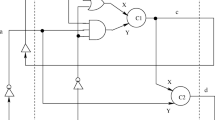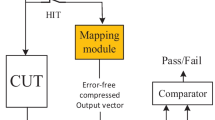Abstract
It is a real challenge to test asynchronous circuits since there is no clock signal, and there are many non-scan state-holding elements. In this paper, we first propose an Asynchronous Circuit Scan (A-SCAN) latch, which can flip between Valid and Empty states so that we can shift in and out without any clock. Experimental results show that our DFT area and power overhead are 28% and 104% smaller than previous synchronous DFT, respectively. The timing overhead of DFT is nearly two times smaller than previous asynchronous DFT. Based on A-SCAN, we propose the Asynchronous Built-in Self Test (A-BIST), which has no clock. Experimental results show that our BIST area and power overhead are 30% and 116% smaller than previous synchronous counterpart, respectively. Our test coverage is similar to that of ATPG. With A-SCAN and A-BIST, we can easily integrate synchronous and asynchronous testing on the same chip.


























Similar content being viewed by others
Data Availability
The datasets generated during and/or analysed during the current study are available from the corresponding author on reasonable request.
References
Akopyan F, Sawada J, Cassidy A et al (2015) TrueNorth: design and tool flow of a 65 mW 1 Million neuron programmable neurosynaptic chip. IEEE Trans Comput Des Integr Circuits System 34(10):15371557
Al-Assadi WK, Kakarla S (2009) “Design for test of asynchronous NULL convention logic (NCL) circuits.” J Electron Test 25(1):117–126
Beest F, Peeters A, Verra M, van Berkel K, Kerkhoff H (2002) Automatic scan insertion and test generation for asynchronous circuits. Proc IEEE Test Conference pp. 804–813
Beign E, Vivet P, Thonnart Y, Christmann JF, Clermidy F (2016) Asynchronous circuit designs for the Internet of everything: A methodology for ultralow-power circuits with gals architecture. IEEE Solid-State Circuits Mag. 8(4):39–47
Chang J, Park SP, Roy K (2010) Exploring asynchronous design techniques for process-tolerant and energy-efficient subthreshold operation. IEEE J Solid-State Circuits 45(2):401–410
Chang K-L et al (2013) “Synchronous-logic and asynchronous-logic 8051 microcontroller cores for realizing the internet of things: A comparative study on dynamic voltage scaling and variation effects” IEEE. J Emerg Sel Topics Circuits Syst 3(1):23–34
Chelcea T, Nowick SM (2004) Robust interfaces for mixed-timing systems. IEEE Trans Very Large Scale Integr (VLSI) Syst 12(8):857873
Cheng CH, Li JCM (2011) An asynchronous design for testability and implementation in thin-film transistor technology. J Electron Test pp. 193–201
Chow A, Coates W, Hopkins D (2007) A configurable asynchronous pseudorandom bit sequence generator. In IEEE International Symposium on Asynchronous Circuits and Systems p. 143152
Fant KM, Brandt SA (1996) Null Conventional Logic: A complete and consistent logic for asynchronous digital circuit synthesis. In International Conference on ASAP p. 261273
Hsieh S-A et al (2018) “DR-scan: Dual-rail asynchronous scan DfT and ATPG.” IEEE Trans Comput Aided Des Integr Circuits Syst
Huang K-Y, Shen T-Y, Li JC-M (2017) “Test methodology for dual-rail asynchronous circuits.” Design Automation Conference (DAC), 2017 54th ACM/EDAC/IEEE
Iwata H et al (2010) “Bipartite Full Scan Design: A DFT Method for Asynchronous Circuits.” In Proc 19th IEEE Asian Test Symposium
Kang Y-S, Huh, K-H, Kang S (1999) “New scan design of asynchronous sequential circuits.” 1st IEEE Asia Pacific Conference on ASICs pp. 355–358
Koppad D, Efthymiou A (2009) “BIST for strongly-indicating asynchronous circuits.” Very Large Scale Integration (VLSI-SoC), 17th IFIP International Conference on. IEEE
NanGate Inc. (2008) NanGate 45nm Open Cell Library, Nangate Inc, California. http://www.nangate.com/
Nemati N, Reed MC, Fant K, Beckett P (2016) “Asynchronous interleaved scan architecture for on-line built-in self-test of null convention logic.” IEEE International Symposium on Circuits and Systems (ISCAS), Montreal, QC pp. 746–749
Petlin OA, Furber SB (1995) “Scan testing of micropipelines.” Proc 13th IEEE VLSI Test Symposium
Petlin OA, Furber SB (1997) “Built-in self-testing of micropipelines.” Advanced Research in Asynchronous Circuits and Systems. Proceedings., Third International Symposium on. IEEE
Sheibanyrad A, Greiner A (2008) Two efficient synchronous-asynchronous converters well-suited for network on chip in GALS architectures. Integration, the VLSI Journal 41(1):17–26
Smith SC, DeMara RF, Ferguson D, Lamb D (2004) Optimization of NULL convention self-timed circuits, submitted to Integration. The VLSI Journal
Spars JJ, Furber S (2001) Principles of asynchronous circuit design a system perspective. Kluwer Academic Publisher, Ch. 2-Ch. 3
Sutherland I, Fairbanks S (2001) GasP: A Minimal FIFO Control. Proc 7th International Symposium on Advanced Research in Asynchronous Circuits and Systems 11:184–193
Teifel J, Manohar R (2004) Highly Pipelined Asynchronous FPGAs Proc. Int’l Symp. Field Programmable Gate Arrays
Zeidler S, Krsti M (2015) “A survey about testing asynchronous circuits.” IEEE European Conference on Circuit Theory and Design (ECCTD)
Author information
Authors and Affiliations
Corresponding author
Additional information
Responsible Editor: V. D. Agrawal
Publisher’s Note
Springer Nature remains neutral with regard to jurisdictional claims in published maps and institutional affiliations.
Rights and permissions
About this article
Cite this article
Chen, TC., Pai, CC., Hsieh, YZ. et al. Clock-Less DFT and BIST for Dual-Rail Asynchronous Circuits. J Electron Test 37, 453–471 (2021). https://doi.org/10.1007/s10836-021-05963-z
Received:
Accepted:
Published:
Issue Date:
DOI: https://doi.org/10.1007/s10836-021-05963-z




